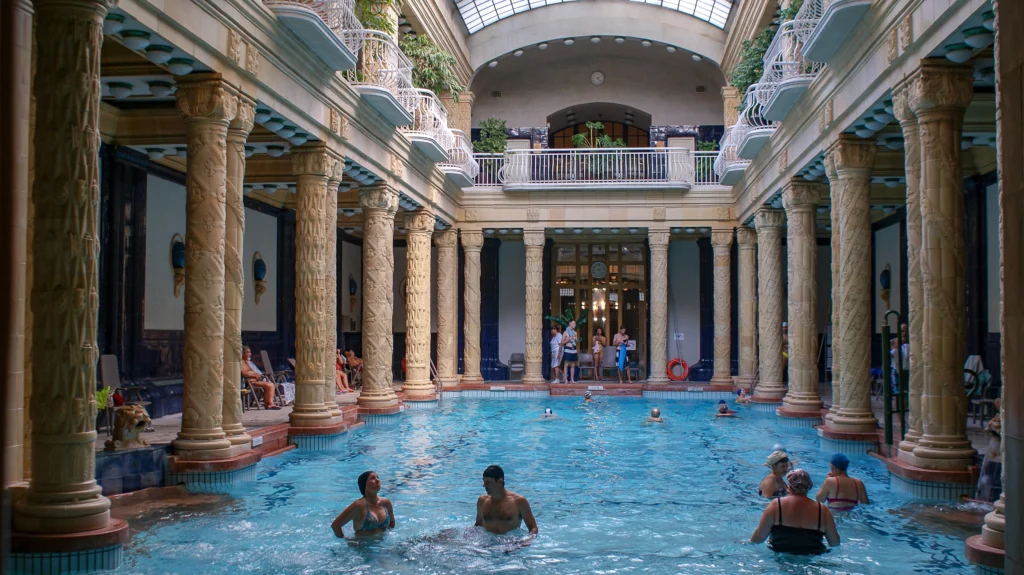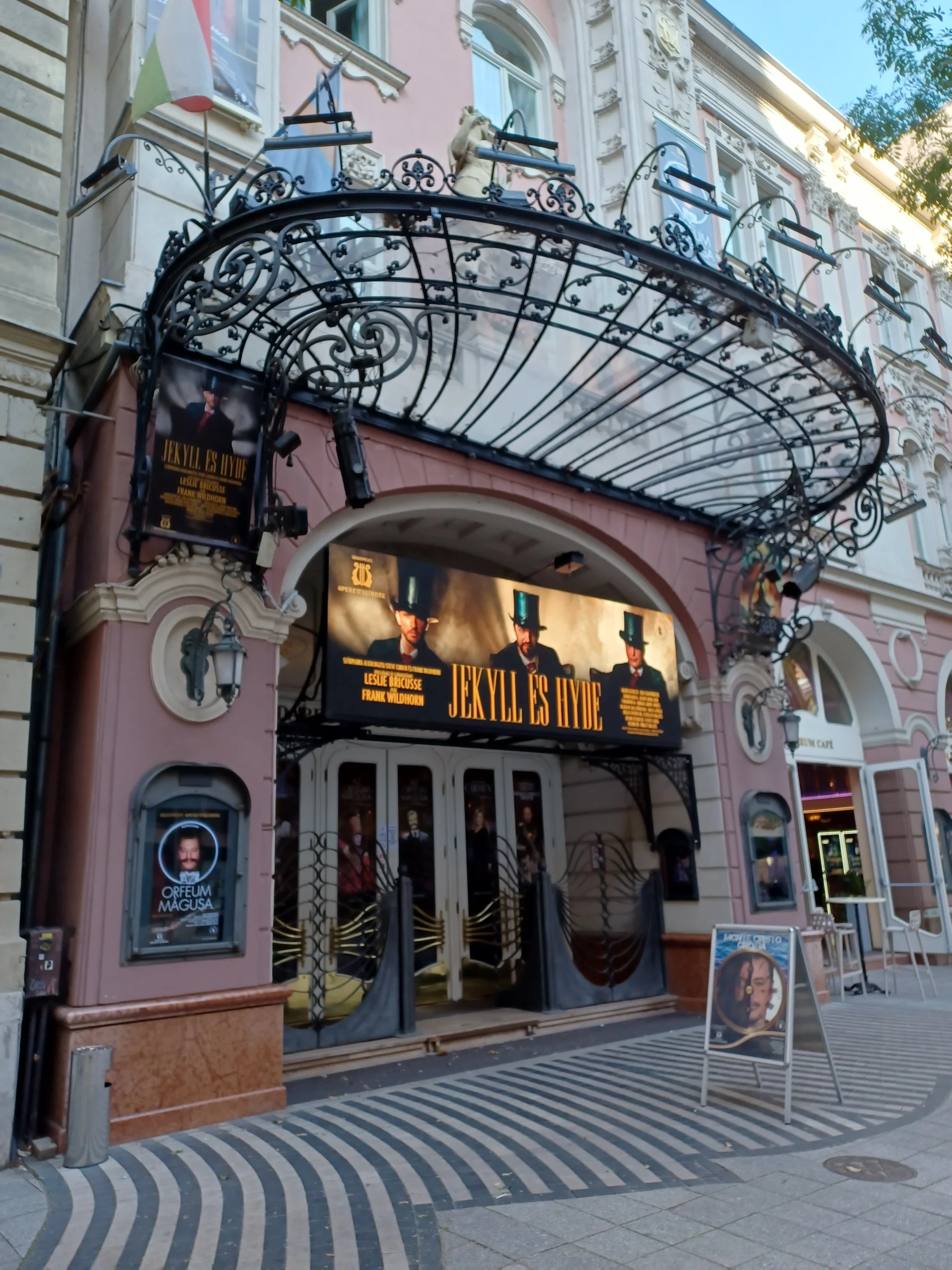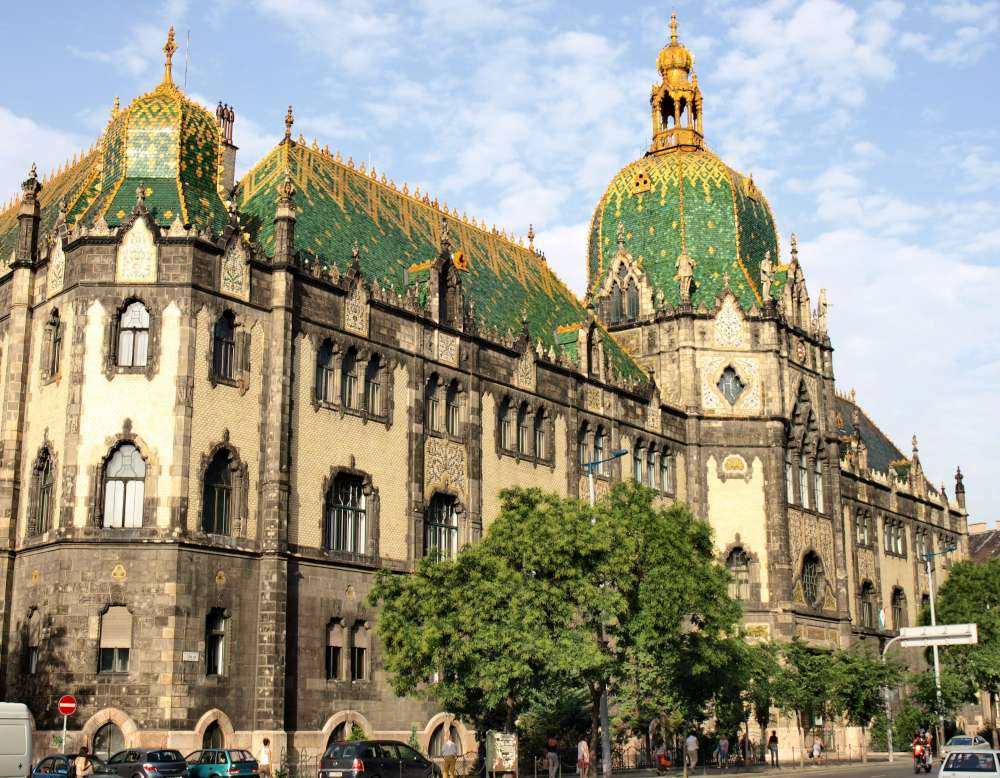Photo by: Travel Hungary Now © – All rights reserved – Unauthorized use is prohibited.
Budapest Operatta Theatre Entrance with beautiful wrought iron balcony grilles and decorative flower ornamentation. Monument ID 7962 Restaurant. – Budapest District VII. Dob Street 53
Budapest Art Nouveau Highlights: The Magic of Magyar Szecesszió
Known locally as Magyar Szecesszió, Hungary’s unique interpretation of the Art Nouveau movement flourished during the late 19th and early 20th centuries, particularly around 1896. This style not only reflects European artistic trends but also incorporates Hungarian folk art and cultural motifs, resulting in an architectural legacy that is as innovative as it is distinctly Hungarian.
The Origins of Budapest Art Nouveau
Historical Context
The Art Nouveau movement emerged in Budapest during a period of rapid modernization and cultural flourishing. As the city expanded and transformed into a European capital, there was a growing desire to break away from historical architectural styles and embrace something new, something that reflected the spirit of innovation and creativity. This desire led to the adoption of Art Nouveau, a movement characterized by its emphasis on natural forms, flowing lines, and decorative elements inspired by the Zsolnay factory.
Budapest Art Nouveau was part of a broader trend across Europe, where cities like Paris, Vienna, and Brussels also witnessed the rise of this new style. However, in Budapest, Art Nouveau took on a distinct flavor, heavily influenced by Hungary’s own cultural traditions and folk art. The result was a unique interpretation of Art Nouveau that remains one of the city’s most enduring legacies.
Key Hungarian Architects
Several architects played pivotal roles in shaping Budapest’s Art Nouveau landscape, with each bringing their vision and style to the movement. Among the most influential were Ödön Lechner, Béla Lajta, and Kálmán Giergl.
· Ödön Lechner: Often referred to as the “Hungarian Gaudí,” Lechner is considered the father of Hungarian Art Nouveau. His work is characterized by the use of Zsolnay ceramics, vibrant colors, and intricate patterns inspired by Hungarian folk art. Lechner’s buildings are some of the most recognizable examples of Art Nouveau style in Budapest.
· Béla Lajta: Lajta’s work is notable for its transition from traditional Hungarian motifs to a more geometric and modern interpretation of Art Nouveau. His designs often incorporated elements of folk architecture but with a more restrained and minimalist approach.
· Kálmán Giergl: Giergl, along with his partner Flóris Korb, was responsible for several prominent Art Nouveau buildings in Budapest. His work is distinguished by its grandeur and attention to detail, making him one of the leading figures in the city’s architectural transformation.
Iconic Art Nouveau Buildings in Budapest
Gresham Palace
Standing proudly at the foot of the Chain Bridge, Gresham Palace is one of Budapest’s most famous Art Nouveau buildings, adorned with Zsolnay ceramic tiles. Originally built as a luxury apartment building and office space for the British Gresham Life Assurance Company, the palace is now home to the Four Seasons Hotel, a symbol of the city’s opulence and architectural splendor.
Architectural Highlights: The facade of Gresham Palace is a masterpiece of Art Nouveau design, featuring intricate wrought iron details, ornate balconies, and expansive stained glass windows. The building’s use of Zsolnay ceramics, a hallmark of Hungarian Art Nouveau, adds a touch of color and texture that enhances its visual appeal. Inside, the grand lobby is adorned with mosaic floors, marble columns, and a sweeping staircase, all of which reflect the elegance and craftsmanship of the era.
Gresham Palace is more than just a building; it is a testament to the artistic and architectural achievements of early 20th-century Budapest. Visitors can admire the façade from the bustling Széchenyi István Square or step inside to experience the grandeur of its interior spaces.
Discover more about Gresham Palace – Four Seasons Hotel Budapest
Museum of Applied Arts – Iparművészeti Múzeum
The Museum of Applied Arts, designed by Ödön Lechner, is another iconic example of Art Nouveau architecture in Budapest. Located on Üllői Avenue, this museum is a celebration of the Hungarian interpretation of Art Nouveau, blending traditional folk motifs with innovative design elements.
Architectural Highlights: The museum’s most striking feature is its colorful ceramic roof tiles, which were produced by the renowned Zsolnay Porcelain Manufactory. The roof’s vibrant hues and intricate patterns are a visual delight, drawing the eye upward to the building’s ornate towers and spires. The facade is adorned with floral motifs, curvilinear forms, and other decorative elements that reflect Lechner’s unique style.
Inside, the museum houses an extensive collection of applied arts, including furniture, textiles, ceramics, and metalwork. The building itself is a work of art, with its grand atrium, sweeping staircases, and detailed ornamentation providing a stunning backdrop for the exhibits.
House of Hungarian Art Nouveau – Magyar Szecesszió Háza – Bedő House – Bedő Ház
While less famous than Gresham Palace or the Museum of Applied Arts, Bedő House is a hidden gem that showcases the beauty of Art Nouveau architecture in Budapest. Located on Honvéd Street, this elegant building was designed by architect Emil Vidor and now houses the Hungarian Art Nouveau Museum.
Architectural Highlights: The facade of Bedő House is a prime example of Art Nouveau design, featuring flowing lines, decorative balconies, and intricate ironwork. The building’s exterior is adorned with floral motifs and other organic forms, creating a sense of harmony and elegance. Inside, visitors can explore the museum’s collection of Art Nouveau furniture, ceramics, and decorative arts, all of which reflect the artistic spirit of the period.
Bedő House offers a more intimate experience of Art Nouveau, allowing visitors to appreciate the finer details of this architectural style in a quieter, less crowded setting.
Read expert insights from Bedő House – Hungarian Art Nouveau Museum.
Postal Savings Bank House – Postatakarékpénztár – Hungarian State Treasury
Another masterpiece by Ödön Lechner, the Postal Savings Bank (Postatakarékpénztár) is a stunning example of how Art Nouveau architecture can combine beauty with functionality. Located on Hold Street, this building was designed to house the Hungarian Postal Savings Bank, and its innovative design has made it one of Budapest’s architectural highlights.
Architectural Highlights: The most distinctive feature of the Postal Savings Bank is its bee-themed decorations, which symbolize industry and thrift. The facade is adorned with intricate ceramic work, including bees, flowers, and other natural motifs is often likened to a grand artistic beehive that harmonizes nature and architecture.. The use of Zsolnay ceramics is particularly striking, with vibrant colors that add a playful yet sophisticated touch to the building’s exterior.
Inside, the building’s design is both practical and aesthetically pleasing, with a layout that maximizes natural light and space. The Postal Savings Bank is a prime example of how Art Nouveau architecture can be both beautiful and functional, making it a must-see for architecture enthusiasts.
Gain a deeper insight on the architect behind the Postal Savings Bank.
Thonet House – Thonet-ház
Located on the bustling Váci Street, Thonet House is an elegant Art Nouveau building originally built as a furniture store for the Thonet company, known for its bentwood furniture. Today, the building stands as a reminder of Budapest’s rich commercial history and its embrace of Art Nouveau design.
Architectural Highlights: The facade of Thonet House is characterized by its curved lines, floral motifs, and decorative ironwork. The building’s design reflects the aesthetic principles of Art Nouveau, with an emphasis on organic forms and intricate details. While the interior has been modernized with an Art Nouveau interior, the exterior retains its original charm, making it a standout on one of Budapest’s busiest shopping streets.
Thonet House is a perfect example of how Art Nouveau architecture was used in commercial buildings, blending artistic beauty with practical purpose.
Gellért Baths and Hotel – Gellért Gyógyfürdő és Szálló

Photo by: DepositPhoto.com – All rights reserved. Do not reuse without permission.
Indoor pool at Gellért Spa in Budapest with ornate Art Nouveau columns, decorative balconies, and people relaxing and swimming under a glass roof.
The Gellért Baths and Hotel, located at the foot of Gellért Hill, is one of Budapest’s most famous thermal baths and a stunning example of Art Nouveau architecture. Built between 1912 and 1918, this complex combines luxurious accommodations with healing thermal waters, offering visitors a unique experience that is both relaxing and visually inspiring.
Architectural Highlights: The grand entrance to the Gellért Hotel is a masterpiece of Art Nouveau design, with mosaic floors, ornate columns, and intricate stained glass windows. The baths themselves are equally impressive, with lavish interiors that include marble pools, elaborate tile work, and decorative statues. The use of natural motifs, such as flowers and waves, is a key feature of the design, creating a sense of harmony between the built environment and the natural world.
The Gellért Baths and Hotel is not only a place to relax and rejuvenate but also a place to admire the beauty of Art Nouveau architecture in one of Budapest’s most iconic settings.
For more information, visit Gellért Thermal Baths – Official Site
Walking Tours and Routes
For those who want to explore Budapest’s Art Nouveau architecture in depth, a walking tour is the perfect way to experience the city’s architectural treasures. A suggested route could start at the Great Market Hall, continue to Gresham Palace, and then move on to the Museum of Applied Arts. Along the way, visitors can also explore lesser-known Art Nouveau buildings and details, such as doorways, balconies, and decorative facades that are scattered throughout the city.
Suggested Walking Tour
- Start at Great Market Hall: Begin your journey at the Great Market Hall, where you can admire the building’s vibrant colors and intricate design.
- Gresham Palace: Walk along the Danube to Gresham Palace, taking in the stunning facade and interior details.
- Museum of Applied Arts: Head towards Üllői Avenue to visit the Museum of Applied Arts, a highlight of Hungarian Art Nouveau.
- Postal Savings Bank: Continue to the Postal Savings Bank on Hold Street to see Lechner’s innovative design up close.
- End at Gellért Baths and Hotel: Conclude your tour at the Gellért Baths and Hotel, where you can relax in the thermal waters while admiring the Art Nouveau surroundings.
Off-the-Beaten-Path Locations
For those looking to explore beyond the main tourist routes, Budapest offers a wealth of hidden Art Nouveau gems. Pay attention to the details as you walk through the city—decorative doorways, ornate balconies, and intricate facades are all around, often in the most unexpected places.
Schiffer Villa
- Location: Városligeti fasor 33
- Designed by Béla Lajta, this villa combines Art Nouveau with early modernist elements, featuring intricate details and murals
Parisiana Nightclub (Párisi Udvar)
- Location: Ferenciek tere
- This former shopping arcade blends Art Nouveau with Moorish and Gothic details, now a luxury hotel.
Róth Miksa Memorial House and Workshop
- Location: Nefelejcs utca 26
- Home to Miksa Róth, a master of stained glass and mosaics, showcasing his iconic Art Nouveau works.
Széchenyi Thermal Bath
- Location: City Park (Városliget)
- The largest medicinal bath in Europe, with Art Nouveau design elements in its interiors and mosaics.
Kőbánya Synagogue
- Location: Állomás utca 14
- An exquisite Art Nouveau synagogue with colorful stained glass and elegant architectural details.
Hungarian Geological Institute
“”- Location: Stefánia út 14
- Another masterpiece by Ödön Lechner, with vivid turquoise and blue zsolnay roof tiles and a unique façade inspired by Hungarian folk art.
Arcade Bazaar – Árkád Bazaar
- Location: Dohány utca
- Features intricate Art Nouveau ironwork and ceramic designs, blending utility with style.
City Park Café Pavilion – Városligeti Café Pavilion
- Location: City Park (Városliget)
- A charming café pavilion with ornate tilework and delicate metal details.
Szent Gellért Thermal Bath and Hotel
- Location: Szent Gellért tér 2
- Famous for its opulent Art Nouveau interiors, stained glass windows, and Zsolnay tiles.
Dob Utca Primary School – Erzsébetvárosi Magyar-Angol Két Tanítási Nyelvű Általános Iskola és Művészeti Szakgimnázium
- Location: Dob utca 85
- Built in 1906 in the Art Nouveau style by architect Ármin Hegedűs, featuring vibrant mosaics by Miksa Róth and a design prioritizing aesthetics and student comfort.
Paris Department Store – Párizsi Nagy Áruház
- Location: Andrássy út 39
- A luxurious early 20th-century Art Nouveau department store, adorned with intricate ironwork, elegant ornamentation, and a stunning glass dome ceiling.
Sonnenberg House
- Location: Benczúr utca 46
- A striking Art Nouveau villa designed by Miklós Román, featuring ornate floral motifs, curvilinear forms, and a harmonious blend of Hungarian folk art with Secessionist style.
Sipeki Villa
- Location: Városligeti fasor 47/a
- An exquisite Art Nouveau villa designed by Ödön Lechner, showcasing colorful ceramic tiles, folk-inspired floral motifs, and a uniquely whimsical roofline.
Szenes Villa
- Location: Városligeti fasor 40
A charming Art Nouveau residence featuring organic floral motifs, intricate wrought iron details, and curvilinear architectural elements typical of the Szecesszió style.
National Institute for the Blind – Vakok Intézete
- Location: Városligeti fasor 37
- A distinguished Art Nouveau building designed by Ármin Hegedűs, featuring intricate brickwork, colorful ceramic decorations, and a functional yet aesthetically pleasing design.
Elephant House at the Budapest Zoo
- Location: Állatkerti krt. 6-12
- A remarkable Art Nouveau structure designed by Kornél Neuschloss, blending exotic motifs with Hungarian folk elements, featuring ornate domes and vibrant Zsolnay ceramic tiles
The Role of Zsolnay Ceramics in Art Nouveau
No discussion of Hungarian capital’s Art Nouveau architecture would be complete without mentioning the Zsolnay Porcelain Manufactory, which played a crucial role in the secession movement. Founded in the 19th century in Pécs, Hungary, Zsolnay became famous for its eosin-glazed ceramics, which are characterized by their iridescent colors and intricate designs.
Zsolnay’s Contribution
Zsolnay ceramics were used extensively in many of Budapest’s Art Nouveau buildings, adding a unique and colorful element to the city’s architectural landscape. The eosin glaze, in particular, was prized for its ability to create a shimmering, metallic effect that enhanced the visual impact of the buildings.
Examples of Zsolnay Work in Budapesn
Some of the most notable examples of Zsolnay ceramics in Budapest can be seen on the roofs of the Museum of Applied Arts and the Hungarian Geological Society. These buildings showcase the vibrant colors and intricate patterns that are hallmarks of Zsolnay’s work, making them standout examples of Art Nouveau architecture in the city.
Preservation and Restoration Efforts
Budapest’s Art Nouveau buildings are not only architectural treasures but also important cultural heritage sites. However, preserving and restoring these buildings is a complex and ongoing challenge.
Current Preservation Initiatives
In recent years, there has been a growing awareness of the need to preserve Budapest’s Art Nouveau heritage. Various initiatives have been launched to restore and maintain these buildings, with a focus on preserving their original features and ensuring their continued use.
Challenges and Success Stories
Restoring Art Nouveau buildings can be a delicate process, as it often involves working with fragile materials like ceramics and stained glass. However, there have been several successful restorations in Budapest, including the renovation of Gresham Palace and the ongoing restoration of the Museum of Applied Arts. These efforts ensure that future generations can continue to enjoy the beauty of Budapest’s Art Nouveau architecture.
To explore this subject further, visit Zsolnay Porcelain Manufactory
Conclusion
Budapest’s Art Nouveau architecture is a testament to the city’s rich cultural heritage and artistic innovation. From the grandeur of Gresham Palace to the intricate details of the Postal Savings Bank, these buildings offer a visual journey through one of the most creative periods in the city’s history. Whether you’re exploring the well-known landmarks or uncovering hidden gems, Budapest’s Art Nouveau treasures are sure to inspire and captivate. So take the time to wander the streets, admire the details, and discover the beauty of Budapest’s Art Nouveau architecture—a journey that will leave you with a deeper appreciation for this remarkable city.
Explore additional insights on Art Nouveau on Wikipedia.
FAQ
What is the Hungarian Art Nouveau style?
The Hungarian Art Nouveau style, known locally as Magyar Szecesszió, blends international Art Nouveau motifs with Hungarian folk art and Oriental influences. It often features colorful ceramic tiles, flowing floral patterns, and decorative ironwork, as seen in many iconic Budapest buildings.
What is the art style of Budapest?
Budapest is renowned for its rich architectural mix, but Art Nouveau stands out for its unique Hungarian interpretation. This style is especially visible in landmarks like the Museum of Applied Arts, Gresham Palace, and the Postal Savings Bank, showcasing organic forms, folk patterns, and Zsolnay ceramics.
What is the difference between Art Nouveau and Art Deco?
Art Nouveau (1890–1910) emphasizes organic, flowing lines inspired by nature, while Art Deco (1920s–1930s) features geometric shapes, bold colors, and luxurious materials. Budapest’s Art Nouveau buildings highlight curves and folk motifs, unlike the more streamlined, modern look of Art Deco.
What is the Art Nouveau walking tour in Budapest?
The Art Nouveau walking tour in Budapest guides visitors through stunning examples of Magyar Szecesszió architecture. Stops often include the Gresham Palace, Museum of Applied Arts, Bedő House, and lesser-known gems like Schiffer Villa, with routes showcasing both famous and hidden buildings.










